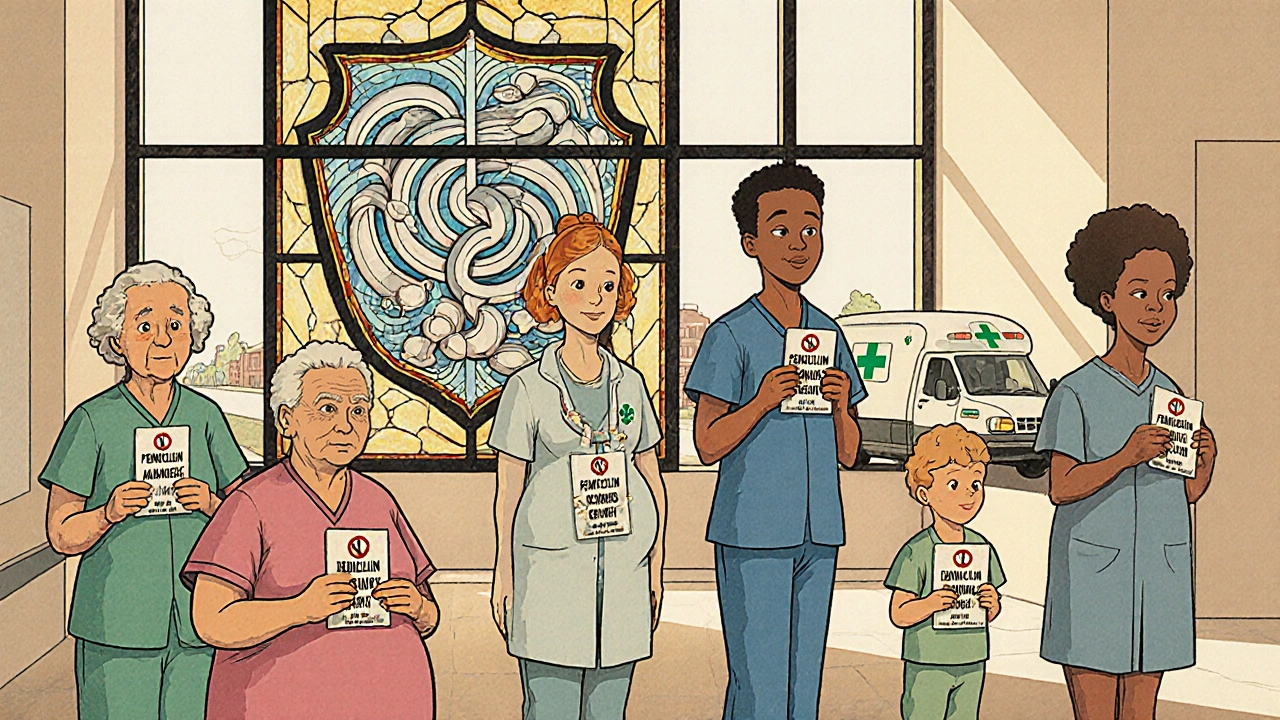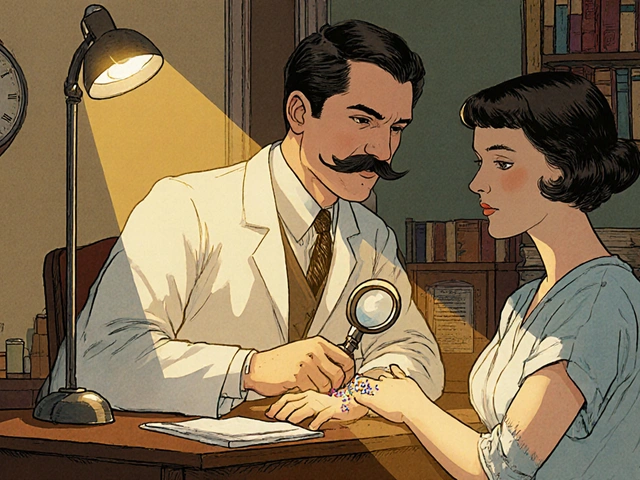If you’ve been told you’re allergic to penicillin or another antibiotic, you might be carrying around a label that’s not even true. About 10% of people in the U.S. say they’re allergic to penicillin, but when tested properly, fewer than 1% actually are. That mismatch isn’t just a small error-it affects your health, your treatment options, and even your wallet. Mislabeling leads to stronger, more expensive antibiotics being used when simpler, safer ones would work just fine. The good news? You can find out for sure if you’re truly allergic with a simple, safe, and well-studied allergy test.
Why You Should Get Tested
Many people think they’re allergic because they had a rash, nausea, or dizziness after taking an antibiotic years ago. But most of those reactions weren’t true allergies. A true antibiotic allergy means your immune system overreacts to the drug, which can cause hives, swelling, trouble breathing, or even anaphylaxis. If you’ve never been tested, you might be avoiding penicillin and its close relatives like amoxicillin or cephalexin unnecessarily. That’s a problem because these drugs are often the best choice for common infections-like strep throat, ear infections, or pneumonia. When you can’t use them, doctors turn to broader-spectrum antibiotics that cost more, cause more side effects, and fuel antibiotic resistance. Studies show that people labeled as penicillin-allergic get broad-spectrum antibiotics 69% more often than those who aren’t. Each year, that adds about $6,000 in extra costs per patient. Worse, it increases the risk of dangerous infections like C. diff and superbugs like MRSA. Getting tested doesn’t just help you-it helps everyone by reducing unnecessary antibiotic use.What Happens During the Test
Antibiotic allergy testing isn’t one single test. It’s a step-by-step process designed to be safe and accurate. It’s usually done in an allergist’s office or hospital setting where emergency equipment is right there. The first step is the skin prick test. A tiny drop of penicillin reagent is placed on your skin, usually on your forearm or back. A small plastic device gently pricks the surface so the substance gets just under the skin. It doesn’t hurt-most people say it feels like a light mosquito bite. If you’re allergic, a red, itchy bump will show up within 15 minutes. If nothing happens, you move to the next step. If the skin prick is negative, the allergist does an intradermal test. A small amount of the antibiotic is injected just under the skin with a thin needle. This creates a tiny bubble (called a bleb). Again, they watch for swelling or redness larger than 3mm. This step is more sensitive and catches reactions the skin prick might miss. If both skin tests are negative, you’ll likely get an oral challenge. You’ll swallow a small dose-usually 10% of a regular pill-then wait 30 minutes. If there’s no reaction, you’ll take the full dose and be monitored for another 60 minutes. This is the gold standard. Even if skin tests are negative, the oral challenge confirms you can safely take the drug. The risk of a serious reaction during this process is extremely low-about 0.06%. That’s less than 1 in 1,000. Allergists always have epinephrine, antihistamines, and oxygen ready, just in case.What to Do Before the Test
Preparation is key. If you’re not careful, medications you’re taking could mess up the results-making a true allergy look like a false negative. You must stop all antihistamines before the test. That includes common over-the-counter drugs like:- Diphenhydramine (Benadryl)
- Hydroxyzine
- Loratadine (Claritin)
- Cetirizine (Zyrtec)
- Levocetirizine (Xyzal)
- Fexofenadine (Allegra)
What to Expect After the Test
Most people feel fine after testing. But some notice mild side effects. About 15% of people get delayed reactions-redness, itching, or swelling at the test site that shows up 4 to 8 hours later. These aren’t signs of a dangerous allergy. They’re just local skin irritation. Over-the-counter hydrocortisone cream helps. A small number of people (around 5-7%) feel anxious, nauseous, or get a mild rash during the oral challenge. If it’s just a feeling of discomfort without hives, swelling, or breathing trouble, it’s usually not an allergy. Your allergist will help interpret what’s real and what’s not. If the test comes back negative, you’re officially “de-labeled.” That means your medical records get updated. You can now take penicillin or related antibiotics safely. No more avoiding them.What If the Test Is Positive?
If you do have a true allergy, your allergist will give you a plan. You’ll get a medical alert bracelet or card to carry. You’ll learn how to avoid cross-reacting drugs. For example, if you’re allergic to penicillin, you might also react to amoxicillin or ampicillin. But here’s something important: allergies can fade. About half of people who had a severe reaction to penicillin in the past lose their allergy within 5 years. Eighty percent lose it within 10 years. That means if you were labeled allergic 10 years ago, you might be fine now. Retesting is safe and worth considering.
Benefits of Getting Tested
The payoff is huge. People who get de-labeled can use first-line antibiotics 87% more often. That means faster recovery, fewer complications, and shorter hospital stays-on average, 1.7 days less per admission. One patient in a 2023 study had osteomyelitis (a bone infection). Before testing, she was on daptomycin, which costs $1,850 per dose. After testing proved she wasn’t allergic, she switched to penicillin at $12 per dose. Her annual antibiotic costs dropped from $67,525 to just $4,380. Every dollar spent on testing saves $5.70 in avoided costs from wrong antibiotics, longer hospital stays, and resistant infections. That’s why top medical groups like the American Academy of Allergy, Asthma & Immunology and the Infectious Diseases Society of America now strongly recommend testing for anyone with a reported allergy.Who Should Get Tested?
You should consider testing if:- You were told you’re allergic to penicillin or another antibiotic, but you’re not sure why
- You had a reaction years ago and haven’t been tested since
- You’ve been prescribed broad-spectrum antibiotics more than once
- You’re preparing for surgery or a procedure where antibiotics are needed
- You’re pregnant and need antibiotics, but you’re worried about your allergy
- You’re a parent whose child was labeled allergic after a rash
What’s Next?
By 2027, 75% of U.S. hospitals are expected to have formal antibiotic allergy de-labeling programs-up from just 42% today. That means testing will become part of routine care, not a rare specialty procedure. New tools are coming too. The NIH just funded research for a point-of-care blood test that could replace skin testing in the future. But right now, skin and oral testing are still the only proven methods. Blood tests for penicillin allergy are not accurate and should not be used. Don’t let an old label hold you back. If you’ve been told you’re allergic to an antibiotic, ask your doctor about testing. It’s simple, safe, and could change how you’re treated for the rest of your life.Can I take penicillin if I had a rash as a child?
Many childhood rashes after antibiotics are not true allergies-they’re often viral rashes or mild side effects. Up to 90% of people who had a rash as a child are not actually allergic. A formal allergy test can confirm whether it’s safe to use penicillin now.
How long does the whole testing process take?
The entire process usually takes about 2 to 3 hours. Skin tests take 15-20 minutes to read. If those are negative, the intradermal test adds another 15-20 minutes. The oral challenge takes 90 minutes total-30 minutes after the first dose, then 60 minutes after the full dose. Most people are done by mid-afternoon.
Is the oral challenge dangerous?
It’s very safe when done in a medical setting. The risk of a severe reaction is only about 0.06%. Allergists are trained to handle reactions immediately. Epinephrine and other emergency tools are always on hand. Most people feel nothing at all during the challenge.
Do I need to stop all my medications before testing?
Only antihistamines and some antidepressants need to be stopped. Essential medications like blood pressure pills, insulin, or thyroid medicine should continue unless your doctor says otherwise. Always tell your allergist everything you’re taking.
Can I be tested for allergies to other antibiotics besides penicillin?
Penicillin is the only antibiotic with a fully standardized test. Testing for other antibiotics like sulfa, vancomycin, or ciprofloxacin is possible but less reliable. If you’re allergic to one antibiotic, your allergist may still test you for others using similar methods, but results are harder to interpret.







Cris Ceceris
Man, I had a rash after amoxicillin when I was 8 and got labeled allergic ever since. Never thought to question it. Just assumed my body hated penicillin. Turns out I probably just had a virus and the drug coincidentally showed up. This post made me realize how many of us are walking around with outdated medical labels like they’re tattoos. I’m scheduling a test next week. If I’m cleared, I’ll finally be able to take the cheap stuff instead of getting slapped with $2k antibiotics every time I get a sinus infection.
Brad Seymour
Bro, this is wild. I’ve been telling my GP for years that I’m allergic to penicillin, but I’ve never actually had anaphylaxis or hives-just a stomachache once in college. Guess I just thought ‘allergy’ meant ‘bad reaction.’ Turns out I’m probably fine. Thanks for the clarity. Also, why is this not standard procedure? Like, why do we still let people carry these labels forever? Someone’s got to fix this system.
Malia Blom
Okay but let’s be real-this whole ‘penicillin allergy’ thing is just Big Pharma’s way of selling you more expensive antibiotics. You think they want you to save $6,000 a year? Nah. They want you on daptomycin. Also, who tests for ‘delayed reactions’? The 15% of people who get redness 8 hours later? That’s not an allergy, that’s your body being mad you took a pill. They’re just pathologizing normal inflammation. And why is the oral challenge ‘gold standard’? Because it’s the only thing that makes them money. I’m not getting poked with needles for a label that was probably wrong to begin with.
Erika Puhan
Let’s not romanticize this. The data looks good on paper, but real-world implementation? Absurd. You need an allergist? Good luck in rural Appalachia or the Midwest. Also, stopping antihistamines for 7 days? What if you have chronic hives? You’re just going to suffer through a week of itching because some study says ‘it’s safe.’ And who’s paying for this? Medicare doesn’t cover it. Medicaid doesn’t cover it. So it’s a luxury for the insured. This isn’t healthcare reform-it’s a privilege for the wealthy.
Edward Weaver
USA still has the best medical system in the world. No other country has this kind of precision testing. You think the UK or India can do this? Nah. They just give you sulfa drugs and hope you don’t die. This is American medicine at its finest-evidence-based, safe, and thorough. Stop complaining about access. If you can’t find an allergist, move to a city. That’s your problem, not the system’s.
Lexi Brinkley
OMG I just got tested last month and it was LIFE CHANGING 😭 I thought I was allergic to penicillin since I was 5 and now I’m like ‘wait I can take amoxicillin??’ I just saved $5k on my daughter’s ear infection 💸💉 Thank you for posting this!! I’m telling everyone 🙌
Kelsey Veg
ok so i read this and im like… wait so i just had to stop zyrtec for a week? i did that and i still got a rash during the test. so like… was it real or was it the zyrtec? idk anymore. also why do they call it a ‘challenge’ like its a game? feels kinda creepy. and why do they need to give you the whole pill? cant they just give you a tiny bit? i felt so weird after.
Alex Harrison
I’ve been a nurse for 12 years and I’ve seen this play out a hundred times. People come in with a penicillin allergy label and then we give them vancomycin or clindamycin because we’re scared. But half the time, they didn’t even have a real reaction. One guy had a rash after taking amoxicillin when he had mono. That’s not an allergy-that’s mono. But the label sticks. I wish more docs would push testing. It’s not hard. Just a few hours and a few pricks. And the savings? Huge. We’re talking real money, real outcomes. Why isn’t this in every primary care office?
Jay Wallace
...And yet, despite all the data, the infrastructure remains woefully inadequate. The American healthcare system is structurally incapable of scaling this intervention-not because of science, but because of bureaucratic inertia, reimbursement disincentives, and the pathological fragmentation of specialist care. The NIH funding a point-of-care blood test? That’s a band-aid on a hemorrhage. We need systemic reform: mandatory de-labeling protocols, EHR auto-flagging of outdated allergy entries, and integration into primary care workflows-not a niche allergist procedure. Until then, this remains a privilege for the informed, the insured, and the privileged. And that’s not progress-that’s pathology dressed up as innovation.